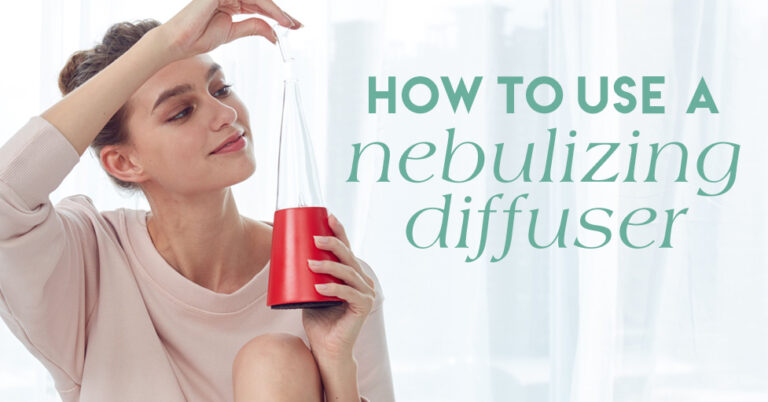Discover the Best Essential Oil for Allergies: Your Guide to Natural Relief
When allergies strike, you want relief that’s both effective and natural. The best essential oil for allergies? Look to lavender, peppermint, and lemon for a start. With tea tree, eucalyptus essential oil, chamomile, frankincense, lemongrass and basil oil also being very effective and useful.
Allergens trigger symptoms that range from itchy skin to sinus headaches, but incorporating the the essential oils found in this guide into your regimen can help reduce inflammation and offer allergy relief.
Essential Insights: Harnessing the Power of Essential Oils for Allergy Relief
Exploring the Top Essential Oils for Allergy Alleviation
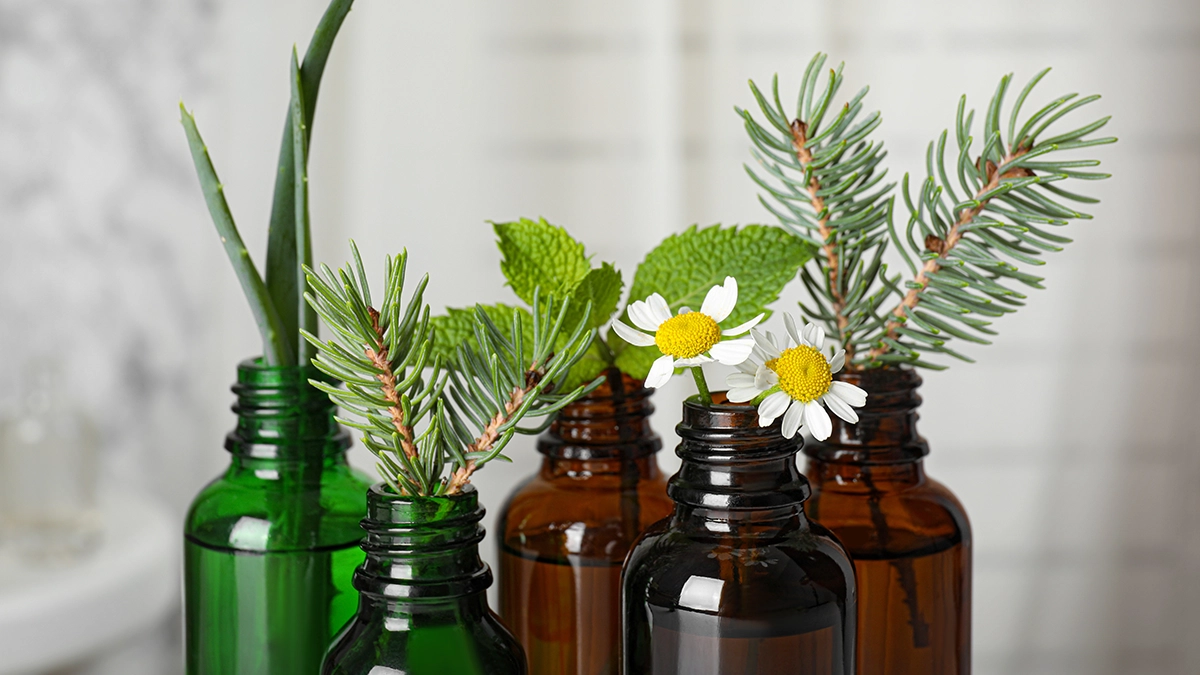
Certain essential oils stand out for their exceptional efficacy in alleviating allergy symptoms, especially those related to seasonal or skin allergies. From runny noses to itchy eyes, these natural remedies can offer relief without the side effects often associated with conventional medications.
Each oil brings its unique therapeutic properties to the battlefield, tackling different aspects of allergic reactions, and providing support to the immune system.
For instance, diffusing Tea Tree oil not only purifies the air by destroying airborne pathogens and helping to relieve upper respiratory tract infections. Its natural antihistamine properties are crucial for allergy sufferers, offering a shield against hay fever and allergic rhinitis without the side effects of drugs.
Similarly, lemon oil acts as a potent antiseptic agent, effectively working to kill bacteria and other germs that can trigger allergy symptoms.
Among the great essential oils for allergy relief, Frankincense and Basil also stand out. Frankincense oil, known for its anti-inflammatory effects, can significantly reduce inflammatory response and sinus pressure, making it invaluable for those suffering from sinus infections or headaches.
Essential Oils for Allergies Table
| Essential Oil | Allergy Symptom Relief | Active Compounds | How It Works |
|---|---|---|---|
| Lavender | Soothes skin inflammation, relieves respiratory symptoms | Linalool, Linalyl acetate | Anti-inflammatory properties reduce skin irritation and swelling. Natural antihistamine effect helps ease respiratory symptoms. |
| Peppermint | Relieves nasal congestion, reduces cough | Menthol | Menthol provides a cooling sensation, acting as a natural decongestant. It also suppresses the release of histamines. |
| Lemon | Reduces allergic inflammation, purifies the air | Limonene, Gamma-terpinene | Anti-inflammatory and antimicrobial properties help reduce allergy triggers and clean the air. |
| Eucalyptus | Clears congestion, eases coughing | 1,8-cineole (Eucalyptol) | Acts as an expectorant, helping to clear mucus from the airways. Reduces inflammation in the respiratory system. |
| Tea Tree | Kills airborne allergens, reduces skin irritation | Terpinen-4-ol, Alpha-terpineol | Antimicrobial properties eliminate airborne pathogens. Anti-inflammatory effects soothe skin reactions.1 |
| Chamomile | Soothes skin rashes, reduces sneezing and itchy eyes | Bisabolol, Chamazulene | Anti-inflammatory and sedative properties help alleviate skin rashes and calm allergic reactions like sneezing and itchy eyes. |
| Frankincense | Supports immune system, reduces inflammatory response | Alpha-pinene, Limonene | Boosts the immune system’s response to allergens. Anti-inflammatory properties help reduce the severity of allergic reactions.2 |
| Basil | Reduces allergic airway inflammation, supports immune system | Linalool, Estragole | Anti-inflammatory and antimicrobial properties help ease respiratory allergies and bolster the immune defense against allergens. |
| Lemongrass | Reduces allergic inflammation, soothes symptoms | Citral, Geraniol | Lemongrass has anti-inflammatory and analgesic properties that help soothe symptoms of allergies, such as inflammation. Its active compounds, particularly citral3, contribute to its effectiveness in managing allergic reactions. |
Basil oil, on the other hand, can fight inflammation and relieve the stuffy nose and scratchy throat that plague many allergy sufferers.
Furthermore, essential oils such as Eucalyptus and Peppermint are renowned for their ability to relieve congestion and relieve allergy symptoms. A few drops of these oils can be immensely beneficial in alleviating itchy skin, skin rashes, and other skin allergies. They are natural anti-inflammatory agents, with properties that help reduce inflammation and fight off dust mites, one of the common triggers for allergies.
These oils, when applied topically or inhaled, can mitigate the severity of allergic reactions by targeting the nervous system and reducing the body’s response to allergens. Their ability to alleviate symptoms like runny nose, watery eyes, and sinus congestion is a testament to how essential oils work to treat allergies at their core.
Essential oils provide a holistic approach to managing allergies, targeting not only the symptoms but also improving overall well-being by enhancing the body’s natural defenses.
Why Do We Get Allergies? Discover Nature’s Solution for Relief
Allergies occur when the immune system overreacts to harmless substances (pollen, dust, pet dander), identifying them as threats. This triggers histamine release from white blood cells, causing symptoms like congestion, itching, and swelling.
Histamines, acting as defense chemicals, increase blood vessel permeability, leading to fluid in tissues (swelling) and mucus production (congestion and runny nose), while activating nerve cells (itching).
Essential oils such as Lavender and Peppermint may soothe these symptoms by reducing inflammation and clearing allergens.
Lavender Oil: The Soothing Sentry

Lavender essential oil is a true blessing for allergy sufferers. Recognized for its natural antihistamine properties, it effectively reduces histamine induced skin inflammation, soothing redness and inflamed areas caused by allergic reactions.
Beyond its allergy relief properties, lavender oil also imparts calming effects, reducing irritation and assisting in relaxing breathing during allergy flare-ups. So, next time allergies strike, consider reaching for your bottle of lavender oil for a soothing sentry against symptoms.
Peppermint Oil: The Breath of Fresh Air
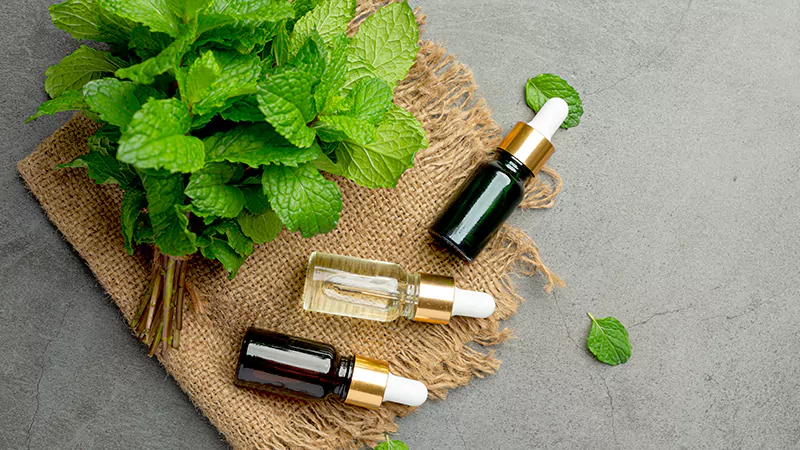
Peppermint essential oil, also known as peppermint oil, is a breath of fresh air, quite literally! Its high menthol content provides a cooling sensation, helping to relieve a stuffy nose and clear the sinuses.
In addition to its analgesic and cough suppressant properties, research shows that menthol can suppress the release of histamines, reducing the severity of allergic reactions. Inhaling the vapor of peppermint oil can effectively alleviate symptoms of allergic rhinitis like nasal congestion and itching.
Lemon Essential Oil: Citrus Cleanse for Allergies
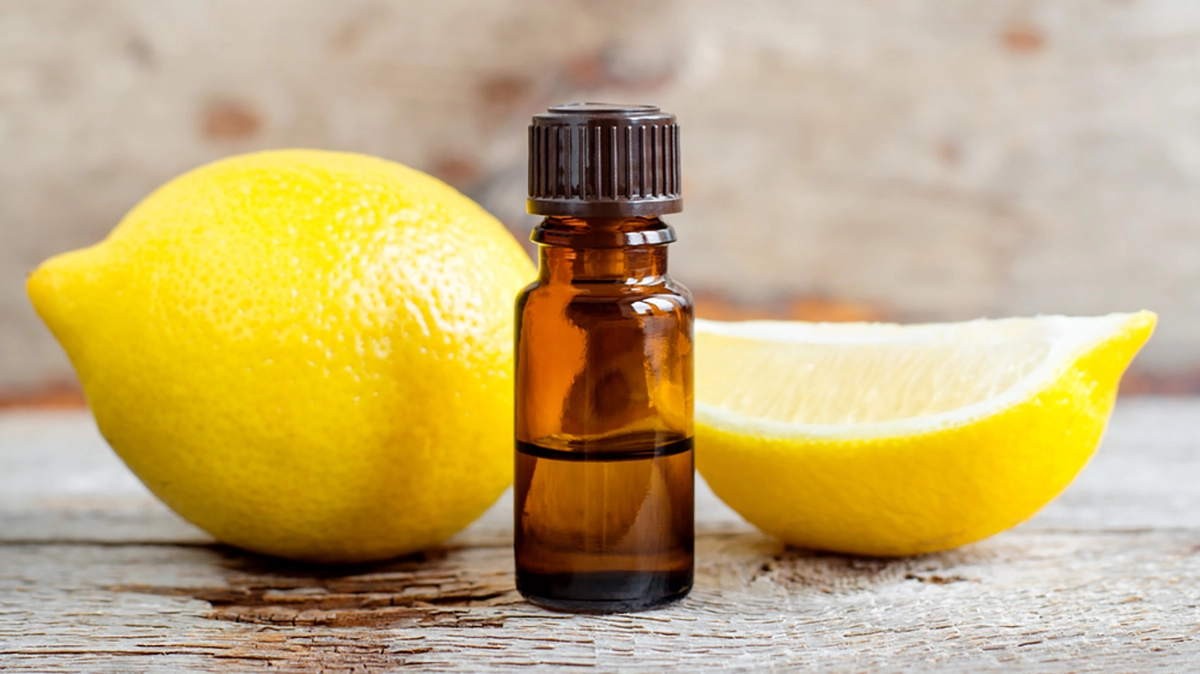
Lemon essential oil is a vibrant player in the field of allergy relief. As a natural antihistamine and with anti-inflammatory properties, it reduces allergic inflammation and calms symptoms during allergy season.
When diffused into the environment, lemon essential oil acts as an antibacterial agent, killing airborne bacteria and thus eliminating potential allergy triggers. This makes it an excellent choice for supporting overall respiratory health.
The Synergy of Essential Oils and Diffusion
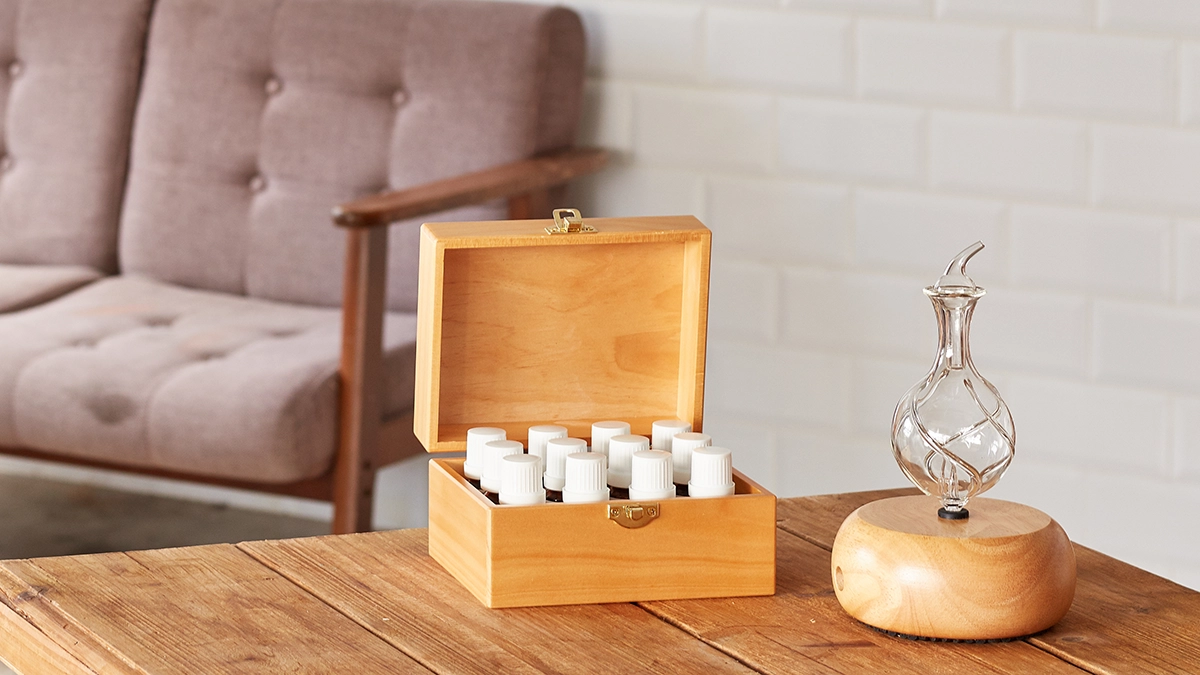
Diffusion stands as an effective method for harnessing the therapeutic benefits of essential oils. Diffusion, particularly through nebulizing diffusers, allows for a highly concentrated mist of essential oils to be dispersed into your environment, offering stronger therapeutic benefits compared to other diffuser types.
Diffusion not only optimizes the effectiveness of essential oils, it also enhances the aromatic experience. Imagine walking into a room filled with the soothing scent of lavender or the invigorating aroma of peppermint – it’s like stepping into a spa!
Choosing the Right Diffuser
When it comes to diffusing essential oils, not all diffusers are created equal. Nebulizing diffusers, for instance, are favored by professional aromatherapists as they disperse essential oils without heat or water, preserving the oils’ integrity and therapeutic properties.
Nebulizing diffusers, available in various designs and materials like hand-blown glass and hardwood bases, cater to diverse aesthetic and functional preferences. Using a minimum of 20 drops of essential oil in a nebulizing diffuser on the LOW volume setting is recommended to achieve optimal dispersion and therapeutic effect for allergy relief.

Sign Up to Get Your FREE
e-Book Here…
Creating Your DIY Essential Oil Allergy Relief Blends Recipes
One of the joys of using essential oils is having the ability to create your own personalized blends, such as essential oils for allergies. For instance, combining eucalyptus oil, known for clearing allergic airway inflammation, with the immune-boosting properties of basil essential oil can create a potent blend for allergy relief.
The following are great recipes you can try at home:
1. Respiratory Allergy Relief Blend
Ingredients:
- 4 drops of Peppermint essential oil
- 4 drops of Eucalyptus essential oil
- 3 drops of Lemon essential oil
- 2 drops of Lavender essential oil
- Optional: carrier oil (such as coconut oil or jojoba oil) for topical application, if desired
Instructions:
For Diffusion: Combine all essential oils in a nebulizing diffuser (minus the carrier oil) according to the diffuser’s instructions. Use in your living area or bedroom to help clear the airways and ease breathing.
For Topical Use: Mix the essential oils with 2 tablespoons (roughly 30ml) of carrier oil. Apply a small amount to the chest, back, and neck areas to help ease respiratory discomfort.
2. Skin Allergy Soothing Blend
Ingredients:
- 5 drops of Chamomile essential oil
- 4 drops of Lavender essential oil
- 3 drops of Tea Tree essential oil
- 2 tablespoons of Aloe Vera gel or unscented lotion as a base
Instructions:
Mix all the essential oils with the Aloe Vera gel or unscented lotion.
Apply gently to the affected areas of the skin to soothe irritation and reduce redness. Store the mixture in a cool, dark place and use within 1 month.
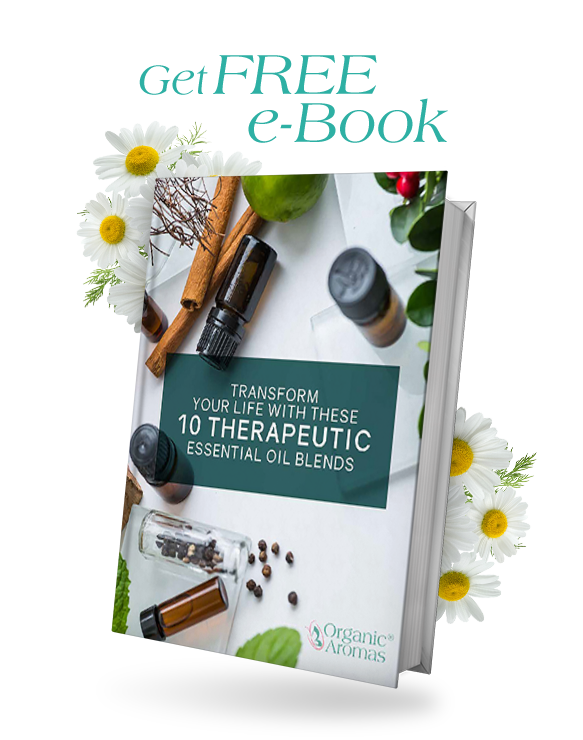
Sign Up to Get Your FREE Essential Oils e-Book Here
3. Seasonal Allergy Support Blend
Ingredients:
5 drops of Lemon essential oil
4 drops of Peppermint essential oil
3 drops of Lavender essential oil
A personal inhaler or a small glass jar
Instructions:
For a Personal Inhaler: Add the essential oils to the cotton wick of a personal inhaler. Inhale as needed to manage seasonal allergy symptoms such as a runny nose and watery eyes.
4. All-Purpose Allergy Relief Spray
Ingredients:
- 8 drops of Eucalyptus essential oil
- 8 drops of Frankincense essential oil
- 7 drops of Lavender essential oil
- 1/2 cup of distilled water
- 1/2 cup of witch hazel
- A 16 oz spray bottle
Instructions:
- Add the essential oils, distilled water, and witch hazel to the spray bottle. Shake well to mix.
- Spray around your home to purify the air, especially during high allergy seasons. Avoid spraying directly on fabrics that may stain.

Practical Application Methods for Allergy Relief
Essential oils can be used in a variety of ways to combat allergy symptoms, each method offering its unique advantages. Whether you prefer to use them topically, inhale them directly, or diffuse them in your environment, the choice is yours.
Topical Use with Carrier Oils
One of the simplest and most effective ways to use essential oils for allergy relief is through topical application. By diluting essential oils with a carrier oil, such as coconut or jojoba oil, you can safely apply them to the skin to combat allergy symptoms.
However, it’s important to follow the recommended dilution ratios to ensure safety and efficacy. For instance, a general guideline for essential oil dilution for adults is a 2-3% dilution, which translates to about 12-18 drops of essential oil per ounce (roughly 30ml) of carrier oil.
Direct Inhalation Techniques
Inhalation is another effective technique for using essential oils to alleviate allergies. By inhaling essential oils directly, you can experience immediate relief from symptoms such as:
- nasal congestion
- sneezing
- itchy or watery eyes
- sinus pressure
One popular method is steam inhalation, where a few drops of an essential oil are added to hot water, and the vapors are breathed in. This technique, particularly with eucalyptus oil, can provide immediate relief for upper respiratory symptoms.
Enhancing Your Environment
Beyond their topical and inhalation applications, essential oils can also be used to enhance your environment. By using a nebulizing diffuser to diffuse essential oils in your home, you can create an atmosphere that not only smells wonderful but also combats allergens and supports respiratory health. While some people may consider using essential oils internally, it is important to focus on the benefits of diffusing them in your environment.
Precautions and Considerations When Using Essential Oils
Even though essential oils provide a natural method to soothe allergy symptoms, their cautious use is essential. Because they are highly concentrated, essential oils can sometimes lead to adverse reactions if not used properly.
Recognizing Quality Essential Oils
As with any product, the best essential oils can vary greatly in quality. Knowing how to recognize high-quality essential oils can make all the difference in your aromatherapy experience.
Look for essential oils that are sold in dark glass bottles, typically less than 4 ounces, to protect the oil from light and heat damage. The label should indicate:
- The common and Latin name of the plant
- Part of the plant used
- Extraction method
- Growth method.
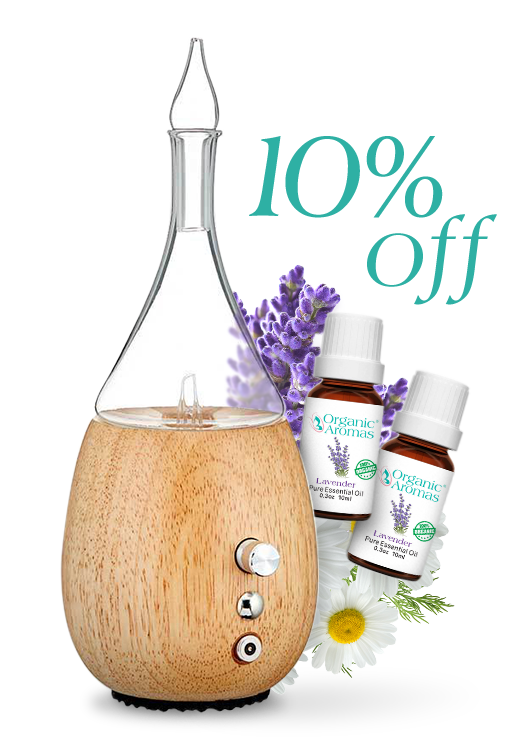
Join Now and Get a Coupon for %10 Off!
Understanding Potential Side Effects
While essential oils have many benefits, they can also have potential side effects. An allergic reaction to essential oils can range from a mild skin rash to more severe symptoms like vomiting, seizures, or shortness of breath.
If you’re using essential oils for the first time, it’s recommended to do a patch test by applying a diluted essential oil to your forearm and covering it for 24 hours to observe any adverse reactions. Always consult with a healthcare provider before using essential oils, especially if you’re:
- pregnant
- nursing
- taking medication
- have a medical condition
- elderly, young child or pets
Tailoring Essential Oil Choices to Specific Allergy Types
Selecting the right essential oil for your allergies involves understanding your individual sensitivities and the specific benefits of each oil. For instance, while eucalyptus oil is effective in easing respiratory allergy symptoms, chamomile essential oil is generally beneficial for seasonal allergies but may worsen symptoms for individuals allergic to ragweed. The crux lies in customizing your essential oil choices to your particular allergy type, taking into account individual sensitivities and contraindications.

Join Our Exclusive Member Club to get Big Discounts!
Essential Oils for Allergies: A Natural Path to Relief – In Conclusion
To sum up, essential oils offer a potent, natural, and aromatic solution for allergy relief. From the calming lavender, the refreshing peppermint to the invigorating lemon essential oil, each offers unique therapeutic benefits to alleviate allergy symptoms. Whether applied topically, inhaled directly, or diffused in your environment, these fragrant essences can transform your space and your well-being. As with any natural remedy, remember to use essential oils with caution, always prioritizing quality, and considering individual sensitivities and contraindications. Embark on your aromatic journey today and breathe easy this allergy season!
Frequently Asked Questions
What essential oil is good for congestion?
Eucalyptus oil is good for congestion, as it helps to clear the airways and relieve nasal congestion. Consider using it for relief.
What is the best natural antihistamine?
The most powerful natural antihistamines with the most research backing their use include stinging nettle, vitamin C, quercetin, butterbur (pyrrolizidine alkaloids free), bromelain, and probiotics. Research has not identified a single best or most powerful natural antihistamine.
What oils do you mix for allergies?
You can mix chamomile, lemon, and lavender oils to relieve allergy symptoms such as runny nose, itchy nose, and nasal congestion. Inhaling a blend of sandalwood, frankincense, and ravensara oils has been shown to improve allergy symptoms like sneezing, runny nose, and congested sinuses, as reported in a study. This suggests that these oils can help with perceived symptoms, quality of life related to allergies, and better sleep.
Where do you rub essential oils for allergies?
You should rub a combination of peppermint, eucalyptus, and lavender essential oils mixed with coconut oil into the temples, behind the ears, and onto the bottoms of your feet to alleviate allergies.
How can I use essential oils for allergy relief?
You can use essential oils for allergy relief by applying them topically, inhaling them directly, or by diffusing them in your environment. Try different methods to see which works best for you.
- Standen, M., & Myers, S., 2004. The roles of essential oils in the modulation of immune function and inflammation: survey of aromatherapy educators. International Journal of Aromatherapy, 14, pp. 150-161
- 2013. Management of basal cell carcinoma of the skin using frankincense (Boswellia sacra) essential oil: a case report.
- Shimizu, K., Gyokusen, M., Kitamura, S., Kawabe, T., Kozaki, T., Ishibashi, K., … & Saito, M. (2014). Suppression of allergic and inflammatory responses by essential oils derived from herbal plants and citrus fruits. International Journal of Molecular Medicine, 33(6), 1643-1651.




